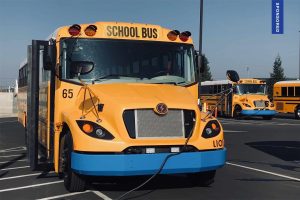August 20, 2023 | Govt to Spend $1 Billion on Electric School Buses

The Clean School Bus Program has been funded with a $5 billion grant from the Inflation Reduction Act that should be appropriately named the Climate Change Act. Around $1 billion of this will be spent on electric school buses. As with all spending plans, the budget quickly jumped from $500 million to $1 billion after the EPA said there was a strong demand. The buses will first be tested in low-income districts, and the people are not happy.
The National Assessment of Educational Progress (NAEP) has reported a drastic dip in test scores since 2020 when the government closed down schools for a virus. Math scores are at a 50-year low. Out of a score of 500, 13-year-old students scored an average of 271 in mathematics. Literacy rates are also declining with the average 13-year-old scoring 256 out of 500. Pre-pandemic, this same demographic scored 260 in reading and 280 in math. “The bottom line — these results show that there are troubling gaps in the basic skills of these students,” said Peggy Carr, commissioner of the National Center for Education Statistics. One troubling report showed that 70% of 10-year-old students could not read after the lockdown worldwide.
There is also a growing shortage of teachers due to low pay and most public schools are lacking basic supplies. A report from June 2022 showed that public schools lost 7% of all instructors (233,000 teachers) between 2019 and 2022. Here in Florida, there are reports on the news all the time of air conditioning systems failing amid a summer heatwave. Schools throughout America lack basic funding, kids are forced to share books, the most fundamental items like pencils are often shared, and the curriculum has nothing to do with becoming a successful member of society.
There are countless issues that public schools face, but let’s focus on spending on buses when that is not an area of concern to anyone outside the Build Back Better climate change crowd. Electric school buses cost between $350,000 and $450,000 – nearly four times more than traditional diesel buses. Need to replace the battery? That could cost around $50,000 to replace and the average lifespan is only 7 to 8 years.
“Who doesn’t love a yellow school bus?” a smiling Harris asked an invitation-only crowd at Seattle’s Lumen Field, with an electric bus behind her. “We are witnessing around our country and around the world the effects of extreme climate,” she said. “What we’re announcing today is a step forward in our nation’s commitment to reduce greenhouse gases, to invest in our economy … to invest in building the skills of America’s workforce. All with the goal of not only saving our children, but for them, saving our planet.”
GOP political candidate Tiffany Smiley offered a word of advice to Harris: “At a time when school test scores are at the lowest levels seen in a generation due to harmful school closures, Vice President Harris and Senator Murray offered ZERO solutions to this education crisis at an event where they claimed to care about what’s best for our children. It’s easy to support infrastructure FUNDING, especially for cleaner buses. But the Democrat’s economic policies have led to labor shortages that threaten to derail infrastructure DELIVERY, with Seattle Public Schools unable to hire enough bus drivers to staff all of their routes. This is a prime example of Patty Murray caring more about the priorities of Washington D.C. over Washington state.”
Yet again the government is funding an imaginary problem while bypassing the real issues that need to be addressed. One BILLION dollars could fund a plethora of items that would improve the lives of the people immediately. This net-zero push is becoming increasingly costly and they want to have it all squared away by 2030. Expect more expensive and unnecessary changes.
STAY INFORMED! Receive our Weekly Recap of thought provoking articles, podcasts, and radio delivered to your inbox for FREE! Sign up here for the HoweStreet.com Weekly Recap.
Martin Armstrong August 20th, 2023
Posted In: Armstrong Economics
Next: Affordability Hell »












